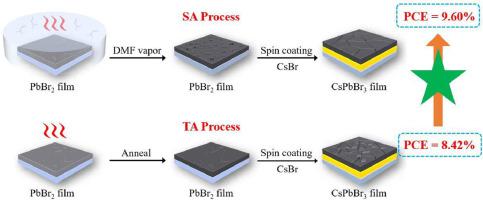Surfaces and Interfaces ( IF 5.7 ) Pub Date : 2023-02-05 , DOI: 10.1016/j.surfin.2023.102707 Kaibo Liang , Yunjia Wu , Qingshui Zhen , Yu Zou , Xiuchun Zhang , Chenhao Wang , Puyao Shi , Yangyang Zhang , Weihai Sun , Yunlong Li , Jihuai Wu

|
In recent years, CsPbBr3 perovskite solar cells (PSCs) have attracted the attention of a large number of researchers due to their excellent temperature and humidity stability. And in the current studies, due to the lack of suitable solvents to dissolve PbBr2 and CsBr at the same time, most studies have used sequential solution-processing techniques (SSPTs) to prepare CsPbBr3 films. However, in the process of the sequential deposition of PbBr2 and CsBr, the uneven reaction could lead to the generation of impure phase (e.g. CsPb2Br5 and Cs4PbBr6), which would deteriorate the photoelectric performance of the device. Here, a solvent-vapor annealing (SA) method has been proposed for fabricating mesoporous PbBr2 films by exposing the PbBr2 films in N,N-Dimethylformamide (DMF) vapor environment. The porous PbBr2 frameworks could facilitate the reaction with CsBr to fully convert into inorganic perovskite CsPbBr3. A series of characterization results show that a compact, uniform and high-quality CsPbBr3 film with large grains was obtained, where the porosity of PbBr2 scaffold could be tuned by the volume of DMF. Consequently, the devices based on optimized PbBr2 films treated by SA method achieved a champion power convention efficiency (PCE) of 9.60%, an open-circuit voltage (VOC) of 1.54 V, a short-circuit current density (JSC) of 7.57 mA cm−2 and a fill factor (FF) of 82.37%, compared with the devices treated by conventional thermal annealing (TA) method achieved a PCE of 8.42%, a VOC of 1.49 V, JSC of 7.31 mA cm−2 and FF of 77.30%. Furthermore, the SA treated devices exhibit more durable stability than TA treated devices, and the SA treated devices still retain 94.28% of its original PCE without any encapsulation in the ambient atmosphere after 30 days.
中文翻译:

用于高性能无机 CsPbBr3 钙钛矿太阳能电池的溶剂蒸汽退火辅助介孔 PbBr2 框架
近年来,CsPbBr 3钙钛矿太阳能电池(PSCs)以其优异的温度和湿度稳定性吸引了大量研究人员的关注。而在目前的研究中,由于缺乏合适的溶剂同时溶解PbBr 2和CsBr,大多数研究采用顺序溶液处理技术(SSPTs)来制备CsPbBr 3薄膜。然而,在PbBr 2和CsBr的顺序沉积过程中,反应不均匀可能导致不纯相的产生(例如CsPb 2 Br 5和Cs 4 PbBr 6), 这会降低器件的光电性能。在此,提出了一种溶剂蒸汽退火 (SA) 方法,通过将 PbBr 2薄膜暴露在N,N -二甲基甲酰胺 (DMF) 蒸汽环境中来制造介孔 PbBr 2薄膜。多孔的PbBr 2骨架可以促进与CsBr的反应以完全转化为无机钙钛矿CsPbBr 3。一系列表征结果表明,获得了致密、均匀、高质量的大晶粒CsPbBr 3薄膜,其中PbBr 2支架的孔隙率可以通过DMF的体积进行调节。因此,基于优化的 PbBr 2的设备SA 法处理的薄膜达到了 9.60% 的冠军功率转换效率 (PCE)、1.54 V 的开路电压 ( V OC ) 、7.57 mA cm −2的短路电流密度 ( J SC )和填充因子 (FF) 为 82.37%,与传统热退火 (TA) 方法处理的器件相比,PCE 为 8.42%,V OC为 1.49 V,J SC为 7.31 mA cm -2和 FF 为 77.30%。此外,经过 SA 处理的设备比 TA 处理的设备表现出更持久的稳定性,经过 SA 处理的设备在 30 天后仍保留其原始 PCE 的 94.28%,没有任何封装在环境大气中。































 京公网安备 11010802027423号
京公网安备 11010802027423号